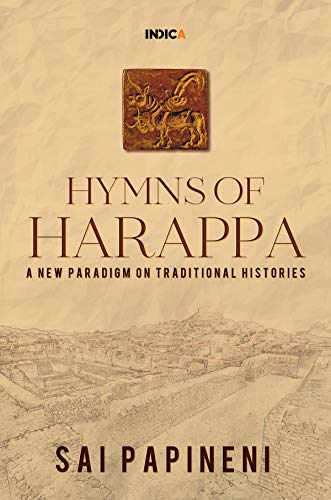Hymns of Harappa : A New Paradigm on Traditional Histories by Sai Papineni - Review by Abhishek Desikan
Hymns of Harappa by Sai Papineni is a thought-provoking book for many reasons. At the outset, the book aims to provide a thesis/postulation to try and reconcile one of the most intriguing mysteries of proto-Indian history - who the Vedic people were and how they were related to the Harappan civilization. Were they the same or two entities that existed in different periods?
To solve this riddle, the author references the Puranic king lists published by Britishman F.E Pargiter in 1922, after years of meticulous research to try and bring out the historicity of Indian tradition based on the Itihasa-Puranas. Most of the book is spent postulating how, by comparing different periods of ancient Indian civilization with the corresponding kings, their histories, and the archaeological, geographical, and other recent scientific evidence, we can understand that the Vedic people and the Harappans were the same and part of the same milieu.
The author provides a lot of maps and other tabular data to put forth his arguments. Key among them are the timelines for the Ramayana matching with the mature Harappan phase between 2600-2000BCE, which signaled growth and prosperity, the start of the Dvapara Yuga coinciding with the late Harappan phase and the end of the Mahabharata war culminating with the dark post-Harappan phase that existed between 1400-600 BCE. There are also calculations based on backtracking the king lists with average life spans from the Mauryan period to Manu himself.
We dive deep into civilizations East and West, the interactions between them and the Harappans, conceptualizing Asuras and Devas w.r.t to immigrants from outside vs. within. The author also speculated on the original location of Ayodhya to be Harappa itself and how the Ramayana took place within the Harappan locations and later included all of Bharatavarsha. While some of his correlations warrant deeper investigation, others do not conform with existing discoveries.
The book also examines the Aryan invasion theory related to these timelines, genetics, linguistics, the spread of languages, and the split between Indo-Aryan and Elamo-Dravidian languages.
It took a lot of work to follow some parts of the book, particularly the explanations of Asuras and Devas, following lineages of the Iksvaku clan, etc. The author tries to focus on too many disciplines and could have made the explanations more lucid. Still, it was an academic and engaging read.

Also published here.